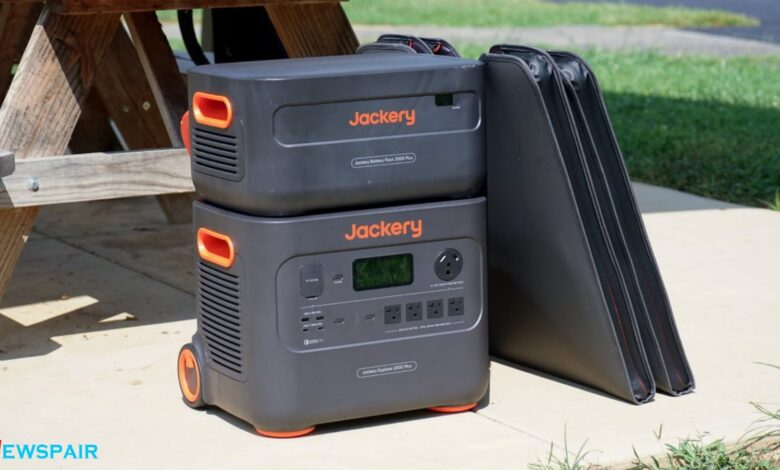Jackery Solar Generator 2000 Plus Review: A Powerful Solution for Clean, Portable Energy

The Jackery Solar Generator 2000 Plus is a powerful and reliable solution for off-grid power, ideal for camping, home backup, and outdoor adventures. This kit includes the Explorer 2000 Plus Power Station, a Battery Pack 2000 Plus, and two 200W SolarSaga panels, creating a comprehensive Jackery Solar Generator 2000 Plus system. The advanced lithium iron phosphate (LFP) battery enhances performance and safety, providing long-lasting power for all your needs. Whether you’re charging devices or running appliances, the Jackery Solar Generator 2000 Plus offers the flexibility and reliability you need.
Features
The Jackery Solar Generator 2000 Plus, paired with two solar panels, offers a robust power solution for most situations. While it’s not designed to run an entire home for extended periods without additional batteries, it’s more than capable of keeping essential appliances running during outages or powering devices on long camping trips.

The Jackery Explorer 2000 Plus offers an impressive base capacity of 2kWh, which can be expanded up to a massive 24kWh—though that full setup would cost around $22,500. For most users, the standard unit combined with one expansion battery delivers a solid 4 kWh, which is more than sufficient for everyday backup or off-grid needs. Roughly the size of a large drink cooler, the unit weighs 61.5 pounds and measures 14.7 inches in height, 18.6 inches in width, and 14.1 inches in depth. Fortunately, it includes a suitcase-style handle and wheels, making it easier to move around despite the weight.
A key feature of the Jackery Solar Generator 2000 Plus is its adoption of LiFePO4 (LFP) battery technology, which is rapidly becoming the preferred choice for larger power stations due to its superior safety and efficiency. Compared to traditional lithium-ion batteries, LFP is not only safer and more efficient but also doubles the lifespan, offering up to 4,000 charge cycles versus 2,000 in older models like the Jackery 3000 Pro.
In terms of connectivity, the Jackery Explorer 2000 Plus includes a total of nine output ports: four 120V/20A grounded AC outlets, one 120V/25A outlet, one car port, two USB-A 3.0 ports (18W max each), and two high-speed USB-C ports (100W max each), providing flexibility for a wide range of devices.

The back of the Jackery Solar Generator 2000 Plus includes multiple input ports: an AC expansion for connecting an additional Explorer 2000 Plus, an AC input for charging through a wall outlet, a DC input for solar panel charging, and a DC expansion for linking the Battery Pack 2000 Plus.
On the front, a display provides all essential information, and power to each output is controlled by dedicated buttons. Additionally, the Jackery app offers remote control of various battery functions. The Jackery Explorer 2000 Plus is priced at $2,199 when purchased directly from Jackery.
Weight and Design
The Jackery Battery Pack 2000 Plus is essentially a more streamlined version of the Jackery Explorer 2000 Plus, without the ports and display.. As a result, it weighs 41.9 pounds, despite being only two-thirds the height of the Explorer model.

The Jackery Battery Pack 2000 Plus provides a 2kWh capacity using LiFePO4 battery technology, but it requires the Jackery Explorer 2000 Plus to function, as it cannot operate on its own. What sets this expansion battery apart is its two DC inputs for solar panels, providing users with additional flexibility for solar panel connections and enhancing the system’s expandability.
For instance, with two expansion batteries, users can position one near the solar panels to recharge in 2 to 7 hours while keeping the other attached to the Explorer 2000 Plus. This setup allows for seamless battery swapping, ensuring the main unit stays charged without needing to keep it near the solar panels. The Jackery Battery Pack 2000 Plus is priced at $1,599 from Jackery; however, it’s important to note that it requires the Explorer 2000 Plus to operate.
SolarSaga 200W Solar Panels
The Jackery kit we’re testing comes with a pair of SolarSaga 200W solar panels. These panels feature an industry-standard 24.3% conversion efficiency and are rated IP67 for durability and water resistance.

Similar to other panels in its class, the SolarSaga 200W panels fold into a compact, briefcase-style design for easy transport. Each panel weighs 17.5 pounds and is constructed with high-efficiency monocrystalline silicon solar cells.
While the 200W rating represents the maximum output, users will likely experience slightly lower performance unless conditions are ideal. During our testing, we consistently saw over 100W from each panel under clear skies and when positioned at an optimal angle to the sun.
The SolarSaga 200W solar panel is available for $699 directly from Jackery.
Using the Jackery Solar Generator 2000 Plus Portable Power Station
We’ve tested a variety of portable power stations, both large and small, and most operate in much the same way: move them to the desired location, power them on, plug in your devices, and supplement with additional power through expansion or solar. As a result, assessing these units goes beyond basic specifications—it’s crucial to consider quality-of-life features, the effectiveness of companion apps, and overall efficiency. While these batteries are designed to charge and discharge, factors such as portability, storage options, noise levels, and real-world performance are much more significant when conducting a thorough review.
Off-roading not Recommended
Despite their name, portable power stations can be cumbersome to move. The batteries are dense and heavy, making these units large and awkward, requiring some effort to transport.

Fortunately, Jackery attempts to address this challenge with wheels and an extendable handle. However, these solutions aren’t perfect.
During our testing, we figured that stacking the battery and extension for easier transport with the wheels would work, given the 100-pound weight. Unfortunately, this approach backfired when the extension battery took a fall onto asphalt, resulting in noticeable damage to the top right corner.
Even on seemingly flat surfaces like asphalt and concrete, small imperfections were enough to cause the heavy unit to vibrate while rolling, eventually dislodging the extension from the top. While this was our mistake, it still felt like a solution that should have worked. Next, we tried moving the battery on its own.
It rolled smoothly over most paved surfaces, but when we encountered gravel, it came to an abrupt stop, yanking the handle from our grip and sending the entire pack crashing to the ground.

When moving off paved surfaces, the wheels quickly become ineffective. While we understand they aren’t designed to handle all transport situations, it would have been helpful to have more durable wheels, especially considering the Jackery Solar Generator is meant for outdoor use. As a result, we found ourselves lifting the battery pack and carrying it to our destination whenever the path wasn’t fully paved. This also meant making an additional trip to retrieve the expansion pack.
Charge, Discharge, and Efficiency
Although other power stations of similar size often feature over ten outputs, the Jackery Solar Generator 2000 Plus comes with just nine. However, this hasn’t posed an issue in our testing, as the range of ports is perfectly suited for our needs. The two USB-C ports, each capable of delivering 100W, allow us to charge our 14-inch MacBook Pro and 12.9-inch iPad Pro without the hassle of bulky power adapters. The USB-A ports are sufficient for charging our iPhone, Apple Watch, and AirPods. Additionally, the four AC outlets are capable of powering essential electronics, including portable lights and cooling units.

At home, the variety of outlets allows us to power our refrigerator during a blackout, charge devices, and still have room to run a fan to circulate air in the intense summer heat. The 25A AC outlet also makes it possible to power appliances in an RV.
The two SolarSaga 200W solar panels work seamlessly together. Although each panel is rated for 200W, it’s uncommon to achieve that output with any solar panel, but using both panels at once typically results in a charging input of 200W to 300W. When charged via an AC port, the Jackery Explorer 2000 Plus can be fully recharged in just 2 hours. With optimal solar conditions and both panels in use, the battery can be fully charged in around 7 hours.

Depending on your needs, this input can ensure that the battery stays fully charged even with heavy use at a campsite. Alternatively, if there’s a power outage at home, it allows you to keep the fridge running for hours beyond what the portable power station could manage alone, thanks to the solar charging.
With a maximum output of 3,000W and a surge peak of 6,000W, the Jackery Explorer 2000 Plus can power most appliances and handle off-grid scenarios. However, larger connected devices will drain the power station faster.
The Jackery Explorer 2000 Plus and its expansion battery operate with minimal noise. When charging or discharging at high rates, the fans increase their speed to improve cooling, but even then, the noise level never exceeded 60 dB when measured next to the exhaust.
The Jackery app’s quiet charging mode reduces the charging speed to keep noise levels below 30 dB. In our experience, the battery produces a low hum under most conditions, which is easily drowned out by music or surrounding noise, making quiet mode unnecessary for most users.
The Jackery app
Similar to other portable power stations, the Jackery app provides users with control over specific features. It’s the sole method for adjusting battery-saving or quiet charging modes. By connecting the battery to the Jackery app, it syncs with your device’s Wi-Fi network, allowing you to monitor the battery’s status and manage its settings remotely.
Portable Enough Power
The Jackery Solar Generator 2000 Plus kit delivers substantial power in a design that’s relatively easy to transport. The built-in wheels help manage the heavy weight, though they work best on smooth or slightly uneven surfaces.

With power outages becoming more common and extreme weather events increasing, having a reliable backup energy source is more important than ever. Whether you need a dependable solution to keep your home essentials running during an outage or want off-grid power for outdoor adventures, the Jackery Solar Generator 2000 Plus is a strong contender. It builds on what made the previous 3000 Pro impressive, offering excellent mobility and enhanced durability thanks to its LFP battery, which prioritizes long-term use over raw capacity.
Jackery Solar Generator 2000 Plus – Pros
- 4 kWh in this 100-pound bundle
- Perfect balance of USB and outlets
- 3,000W max output, 6,000W surge
- Wheels!
Jackery Solar Generator 2000 Plus – Cons
- Wheels can’t go off-roading
- Heavy for a portable object, made worse by an expansion battery.
- High-priced package at $5K
- High-priced package at $5K
Rating: 4 out of 5
Our overall rating centers on the performance of the standalone portable power unit. With its 2kWh capacity and the ability to expand significantly, the Jackery Solar Generator 2000 Plus stands out as a reliable source of portable power. However, we do see room for improvement—more rugged wheels would enhance mobility in rougher terrain, and a secure stacking mechanism for the expansion battery would make transport much more practical.
Conclusion
The Jackery Solar Generator 2000 Plus offers a compelling blend of power, portability, and expandability, making it a solid choice for both home backup and outdoor use. Its LiFePO4 battery provides improved longevity and safety, while the modular design allows users to scale up their power supply based on their needs. Though the mobility features could be more rugged and the expansion battery easier to transport, these are minor trade-offs for an otherwise efficient and versatile energy solution. Whether you’re preparing for emergencies or planning to go off-grid, this power station delivers dependable performance in a compact, user-friendly form.



